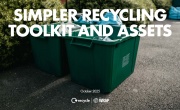WEEE reprocessors criticise Defra over lower collection targets
Following news that the 2017 collection target for waste electrical and electronic equipment (WEEE) was missed by almost 100,000 tonnes, the government has proposed reducing 2018 targets by 14 per cent, triggering dismay from the industry.
The latest statistics from the Environment Agency (EA) showed that 522,901 tonnes of WEEE were collected by producer compliance schemes in 2016/17, falling short of the 2017 target of 622,033. The achieved figure is also almost 60,000 tonnes less than the amount collected the previous year.
The first draft of the 2018 targets from the Department for Environment, Food and Rural Affairs (Defra) sets out a proposed aim of 532,818, which is a 14 per cent decrease from the missed 2017 target. This means compliance schemes would be required to collect only 9,919 tonnes more than was achieved in 2017.
The news has received condemnation from some in the industry. The Environmental Services Association (ESA), representing the UK waste management and recycling industry, said it welcomed the opportunity to comment on the proposed targets before they are finalised on 31 March.
ESA members have blamed the 2017 collection shortfall on leakage from the system, claiming the problem lies in ‘illegal activity’ and poor recording of WEEE prepared for reuse which is not then classified as waste. In a statement released yesterday (15 March) the ESA said: ‘The correct response to this situation is not to reduce WEEE collection targets to the level of 2017 collections, as Defra proposes, but to hold 2018 targets at broadly 2017 levels while tackling the problem of illegal leakage and non-recording of the WEEE that is out there.’
Roy Hathaway, ESA Policy Adviser, commented: “Defra should heed the criticism from right across the waste management sector that reducing the WEEE collection targets by 14 per cent is not the right way to tackle the shortfall in last year’s targets, much less to move the industry forward to meet the higher targets for 2019 and beyond.”
He added that new actions to address illegal leakage of WEEE should be funded with the revenue raised through last year’s compliance fees.
Targets 'lack ambition'
The AATF (Approved Authorised Treatment Facility) Forum, representing operators of WEEE processing plants, said the proposed 2018 targets ‘lack ambition’, agreeing with the ESA that there is ‘significant leakage’ in the system and adding that the compliance fee system has created a ‘lack of incentive to collect WEEE’, leading to ‘potentially obligated WEEE being processed through informal – and often environmentally damaging – disposal routes’.
With the UK continuing to move the goalposts closer, it is unclear whether the country will be able to meet the challenge of the EU-wide WEEE targets, which are set to rise in 2019 to 65 per cent of the weight of new products placed on the market. However, it has been questioned how successfully the UK’s WEEE collection targets reflect the evolving nature of the material.
Mark Burrows-Smith, CEO of the country’s largest WEEE compliance provider REPIC, suggested in September last year that the 2017 targets were too ambitious, adding: “REPIC strongly believes that more evidence-based research is required to help set future collection targets.” He raised the point that the tonnage of household electrical and electronic equipment (EEE) put on the market has been falling year on year, making it “unsurprising” that the amount of WEEE produced is down.
John Redmayne of the European Recycling Platform UK also suggested that reasons for the missed target could be more nuanced, asking: “is more WEEE being collected outside of the producer compliance system? Are EEE and WEEE getting lighter? Do these explain why collections of most WEEE streams - particularly LDA and Display - have dropped? And is this why less EEE was put on the UK market than in the previous year for the first time in five years?”









